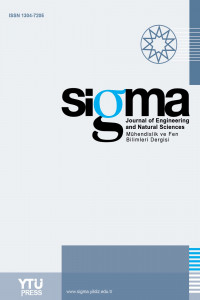IMPLEMENTATION OF AN MS EXCEL TOOL FOR BACKPROPAGATION NEURAL NETWORK ALGORITHM IN ENVIRONMENTAL ENGINEERING EDUCATION
Abstract
This paper presents the implementation of an MS Excel tool for backpropagation neural networks in environmental engineering education. A number of test cases, Darcy friction factor and oxygen solubility, were also provided to test the performance of the tool. Relative mean square errors and coefficients of determination for Darcy friction factor were calculated as 1.53*10-3±0.59*10-3 and 0.9983±0.0003 while they were calculated as 4.78*10-4±2.33*10-4 and 0.9998±0.0000 for oxygen solubility. Results suggested that the tool’s performance is satisfactory. The tool produces satisfactorily fast and reliable results and can be used for environmental education in undergraduate/graduate level.
References
- [1] Henze M., Gujer W., Mino T., Matsuo T., Wentzel M.C., Marais G.v.R., (1999) Activated sludge model No. 2d, Water Sci. Technol. 39(1), 165-182.
- [2] Ostace G.S., Critea V.M., Agachi P.Ş., (2011) Cost reduction of the wastewater treatment plant operation by MPC based on modified ASM1 with two-step nitrification/denitrification model, Comput. Chem. Eng. 35, 2469-2479.
- [3] Demir S., Saral A., (2011) A new modification to the chemical mass balance receptor model for volatile organic compound source apportionment, Clean-Soil Air Water 39(10), 891-899.
- [4] Demir S., Saral A., Ertürk F., Kuzu S.L., Goncaloğlu B.İ., Demir G., (2012) Effect of diurnal changes in VOC source strengths on performances of receptor models, Environ. Sci. Pollut. R. 19(5), 1503-1514.
- [5] Demir S., Karadeniz A., Manav-Demir N., (2016) Artificial neural network simulation of cyclone pressure drop: Selection of the best activation function in Iraq, Pol. J. Environ. Stud. 25(5), 1891-1899.
- [6] Şamlı R., Sivri N., Sevgen S., Kiremitci V.Z., (2014) Applying artificial neural networks for the estimation of chlorophyll-a concentrations along the Istanbul Coast, Pol. J. Environ. Stud. 23(4), 1281-1287.
- [7] Elsayed K., Lacor C., (2012) Modeling and pareto optimization of gas cyclone separator performance using RBF type artificial neural networks and genetic algorithms, Powder Technol. 217, 84-99.
- [8] Demir S., Karadeniz A., Manav-Demir N., (2016) Using steepness coefficient to improve artificial neural network performance for environmental modeling, Pol. J. Environ. Stud. 25(4), 1467-1477.
- [9] Bayram A., Kankal M., (2015) Artificial neural network modeling of dissolved oxygen concentrations in a Turkish watershed, Pol. J. Environ. Stud. 24(4), 1507-1515.
- [10] Jahandideh S., Jahandideh S., Asadabadi E.B., Askarian M., Movahedi M.M., Hosseini S., Jahandideh M., (2009) The use of artificial neural networks and multiple linear regression to predict rate of medical waste generation, Waste Manage. 29(11), 2874-2879.
- [11] Aghav R.M., Kumar S., Mukherjee S.N., (2011) Artificial neural network modeling in competitive adsorption of phenol and resorcinol from water environment using some carbonaceous adsorbents, J. Hazard. Mater. 188, 67-77.
- [12] Hernandez-Ramirez D.A., Herrera-Lopez E.J., Rivera A.L., del Real-Olvera J., (2014) Artificial neural network modeling of slaughterhouse wastewater removal of COD and TSS by electrocoagulation, Stud. Fuzziness Soft Comput. 312, 273-280.
- [13] Ye J., Cong X., Zhang P., Zeng G., Hoffmann E., Wu Y., Zhang H., Fang W., (2015) Operational parameter impact and back propagation artificial neural network modeling for phosphate adsorption onto acid-activated neutralized red mud, Journal of Molecular Liquids 216, 35-41.
- [14] Sibi P., Jones A.A., Siddarth P., (2013) Analysis of different activation functions using back propagation neural networks, Journal of Theoretical and Applied Information Technology 47(3), 1264-1268.
- [15] Colebrook C.F., (1939) Turbulent flow in pipes, with particular reference to the transition region between the smooth and rough pipe laws, Journal of the Institution of Civil Engineers 11(4), 133-156.
- [16] Swamee P.K., Jain A.K., (1976) Explicit equation for pipe flow problems, J. Hydraul. Eng-ASCE 102, 657-664.
- [17] Buzelli D., (2008) Calculating friction in one step, Mach. Des. 80, 54-55.
- [18] Avcı A., Karagoz I., (2009) A novel explicit equation for friction factor in smooth and rough pipes, J. Fluid. Eng-T ASME 131(6), 061203.
- [19] Brkic D., (2011) An explicit approximation of the Colebrook equation for fluid flow friction factor, J. Petrol. Sci. Eng. 29, 1596-1602.
- [20] Fang X., Xu Y., Zhou Z., (2011) New correlations of single-phase friction factor for turbulent pipe flow and evaluation of existing single-phase friction factor correlations, Nucl. Eng. Des. 241, 897-902.
- [21] Holenda B., Domokos E., Redey A., Fazakas J., (2008) Dissolved oxygen control of the activated sludge wastewater treatment process using model predictive control, Comput. Chem. Eng. 32, 1270-1278.
- [22] Botheju D., Lie B., Bakke R., (2009) Oxygen effects in anaerobic digestion, Model Ident. Control 30(4), 191-201.
Details
| Primary Language | English |
|---|---|
| Subjects | Engineering |
| Journal Section | Research Articles |
| Authors | |
| Publication Date | March 1, 2018 |
| Submission Date | April 6, 2017 |
| Published in Issue | Year 2018 Volume: 36 Issue: 1 |
IMPORTANT NOTE: JOURNAL SUBMISSION LINK https://eds.yildiz.edu.tr/sigma/


